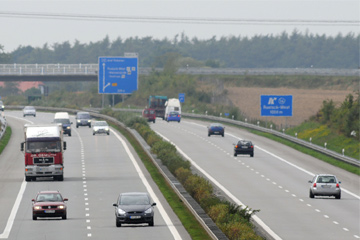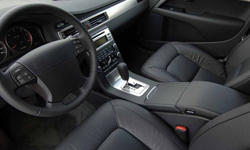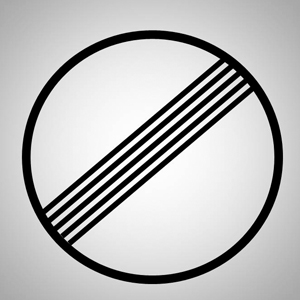 Vehicles drive on the German highway A20 from Luebeck to Stettin, near Rostock, northern Germany.
/Frank Hormann
Vehicles drive on the German highway A20 from Luebeck to Stettin, near Rostock, northern Germany.
/Frank Hormann
Let's say it together -- autobahn. The harsh German syllables contradict the images the word conjures in the mind of speed freaks the world over. Fueled by on-line videos of turbo-powered Porsches, drivers see themselves pushing 200 miles per hour (321.9 kilometers per hour) on smooth ribbons of highway through the Bavarian heartland. It's a vision that would warm any racer's soul and get the secret racing heart of a soccer dad beating just a little faster.
But it's only a pipe dream, really. Or at least most of it is, anyway. Instead the autobahn, or Bundesautobahn as it's known in German, is simply a federal highway system. Most German drivers consider it point A to point B transit, kind of like the U.S. Interstate System without the speed limit.
And that's the allure, the siren song, the attraction -- no speed limit. If your car can top 150 miles per hour (241.4 kilometers per hour), or even 200 miles per hour (321.9 kilometers per hour) or more, then feel free to mash the accelerator and feel the G-force crush you into the seat.
Just make sure you're on the right autobahn -- there are three national systems, after all. And with less than a quarter of the total federal highway system open to unlimited speed, make sure you're not breaking a law by zooming through a construction zone, an urban area, a convergence or divergence, or exceeding a safe limit as imposed by weather conditions.
The autobahn might be the stuff of dreams, but the reality -- where the rubber meets the road, so to speak -- is actually the stuff of every day.
Keep reading to learn about the allure of the autobahn, as well as why it's just another road.
On August 6, 1932, the first German automobile road was opened between Cologne and Bonn. The road was strictly for the use of cars and motorcycles, it had no cross streets and slower vehicles like horse-drawn carts were banned from using it.
While not an "autobahn" per se, it was the seed of what would become the nation's highway system.
By the late 1930s the Nazi Party began taking over the country's political system. Adolph Hitler rose to power, and his aggressive military campaigns needed a viable and established road system to move men and war material. From these circumstances the autobahn was born.
National Socialism arose during a time of economic hardship for Germans. Hiltler saw the potential of the roads to produce jobs and spur national growth and began an aggressive road building campaign under the Reichsautobahnen supervision. The roads were the first high-speed limited-access roads in the world at the time. These first sections were even used for Grand Prix race car testing at times.
Gas shortages during WWII resulted in a neglect of the roads, which were found to be too steep and winding for much military traffic. Further, German citizens simply could not afford the gas to drive the roads during the war years. By the end of the war many of the roads were neglected to the point of impassability. A reconstructed Germany began a campaign to restore the roads and add more miles. By the 1990s, following German unification, the road system had caught the imagination of the world and "autobahn" was synonymous for the speed and drivability we see today. And while the future of the roadway's unrestricted speed may be in question, it's doubtful the autobahn will be a thing of the past anytime soon.
For more information about Germany's autobahn, follow the links on the next page.
Various movies and slew of YouTube videos have cropped up either referencing or being tied-in to the autobahn. But only one band has really embraced the Germans' love for their road system. Kraftwerk, a German electronic band formed in the 1970s, produced and recorded the song "Autobahn." It's one of the few musical tributes to the German federal highway system known at this time.

Sources
 Perhaps no other symbol can make a heart (or a car) race faster than the German Bundesautobahn "derestriction" symbol. It essentially gives drivers the green light to drive as fast as they wish.
to its limits.
Perhaps no other symbol can make a heart (or a car) race faster than the German Bundesautobahn "derestriction" symbol. It essentially gives drivers the green light to drive as fast as they wish.
to its limits.
The reason for this is simple -- The autobahn was never designed as a speed playground. Bundsesautobahn in German translates to "federal motorway." Similar autobahns are established in Switzerland, Austria, Spain and Portugal. Like the United States, these systems were designed to be an efficient transportation network to spur commercial development and allow for military transport in times of national emergency. Speed is just a byproduct rather than an end, though Germans do admit a certain pride in the association between fast cars and their highway system.
As in America, the autobahn has a posted minimum speed -- 37 miles per hour (59.6 kilometers per hour). This prohibits the use of mopeds, bicycles, smaller cars and other, slower forms of transport on the roads -- including an original and still-standing ban on horse-drawn vehicles.
Maximum speed limits, imposed in heavy congestion areas, environmentally-sensitive stretches, urban areas and where highways merge and diverge, can range from 40 to 100 miles per hour (64.4 to 160.9 kilometers per hour).
Of course these speeds are modified by road conditions, weather conditions and a host of other factors. For instance, a ban on eating and drinking in a car is not only on the books but enforced. For instance, if a driver is pulled over by the police, they can receive an additional fine if the officer determines they were driving and eating -- considered a distracted state.
In 2009, the transport ministry instituted the "Runter vom Gas" campaign, "Kill your Speed" in English. This successful campaign is aimed at younger drivers with a lead foot and access to the autobahn. Reports indicate the campaign has had some success in reducing the number of traffic-related fatalities in that age group [source: BMVBS].
While Germany does offer stretches of speed-limit-free highway, there can be a heavy price to pay if a driver is caught disregarding the country's strict vehicular rules and regulations. Read the next page to find out how a speeding thrill can turn into a speeding ticket.